We last climbed to the top of the mountain at Sněžka, which rises on the Czech-Polish border: surrounded by an opal-white mist, the temperature can reach minus 5 degrees, which makes the icy wind unpleasantly bitter. We reached an altitude of 1600 metres, after a three-hour climb. We passed a hole dug in the snow. At the bottom of the hole was a door, and a man came out of it.
What is this? – I ask my companion who has been there several times. He says: a bar. A little further away is a box-shaped building covered in 10cm thick ice crystals, and large bags are thrown through its door. and this is? – I inquired. Post Office, the answer is coming. Another fifty meters and a huge bowl unfolded from the fog. Dozens of hikers wander below, as heavily dressed as we are.
Suddenly, a new team arrives: with a bare upper body and shorts.
What? Well, it would be good to wake up!
We won't even wake up, but now let's go back to the beginning of the tour. We are on our usual annual visit to relatives in Prague, which we always combine with a trip or two to the Czech Republic. Since the Czech Republic is not a big country and Prague is very popular among Hungarians, I have a great suggestion for how to get rid of a light hangover after a good Czech beer: go for a walk. We can get almost anywhere within an hour or two.
You can take long walks in the relatively nearby natural rock towns – I've written about Czech Switzerland here and Czech Paradise here before. But the most important winter tip is to climb the highest mountain in the Czech Republic, the 1,603-metre-high Snezka. There is a high probability that the mountain will be snowy in winter, and it is no coincidence that the Czechs called it Havas-tető in Hungarian. Poles (Śnieżka) and Germans (Schneekoppe) as well, as the mountain range has been a Polish, German, Prussian or royal border for a long time in the storms of history. It is now a very popular hiking area on the Czech-Polish border, which is now completely virtual thanks to the Federation.
The top of the mountain from both countries is easily reached, for the lazy, by cable car, but let's stick to hiking. In winter, the only avalanche safe route from the Czech Republic starts from the resort town of Pec pod Sněžkou. In essence, it can be divided into a shorter forest path and a longer, more comfortable path on the hills. Since we want to be sure, we also rent snowshoes from the rental shop below, so that conquering the summit does not depend on them by chance.
You can park your car exactly at the beginning of the green tourist route, but the stop of the direct bus route to Prague is not far away. Initially, the path winds its way through a forest of Scots pines, and then the path intersects low-growth pine forests, reaching almost to the ground, with snow-covered canopies. There is no air movement, layers of coats falling off one by one during the sweaty climb. The snow is about 30 cm thick, but not on the road, because it is carefully trampled there. It does slip a little, but not seriously.
This is how we reach the ridge indicated by the Růžohorky mountain refuge at an altitude of 1250 metres. This means that it indicates whether we can see something in the fog that replaces the dense forest in space. We rest and drink a cup of hot tea from the thermos we brought with us. We can go home, but it will be too early to relax. We set off on the hilly road which we had previously feared due to the heavy snow. I shouldn't have.
A wide, well-thought-out path leads along the ridge, it's true, under heavy snow, but you don't really need snowshoes. After a quarter of an hour, the clouds dispersed and the sky turned blue under the snow-covered pine trees on the ground. It's almost sweet, I can't wait to see when a Cyrbolya or Borbolya emerges from under one of the cones. Unfortunately, the happy fairytale mood soon ends, and another huge gray-white cloud arrives and rears its ass on the mountain.
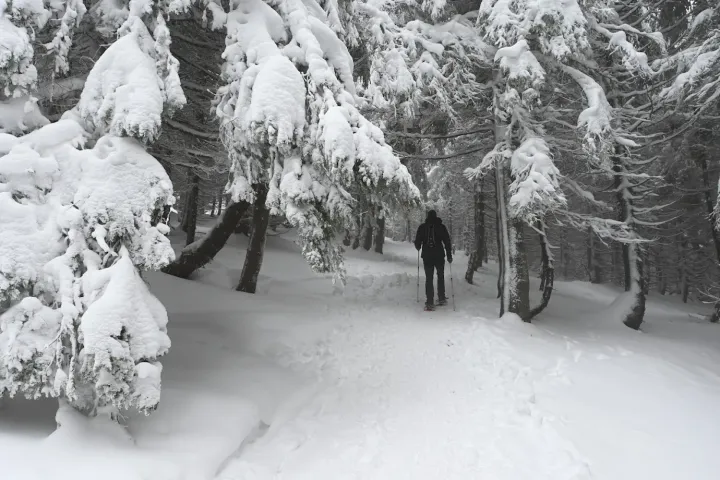
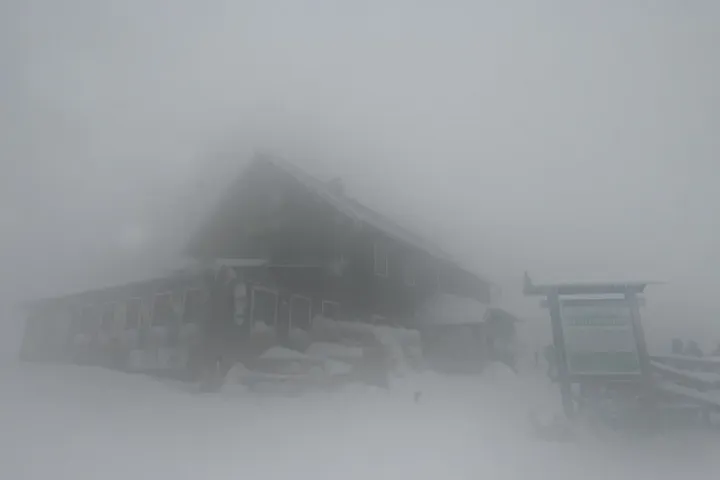
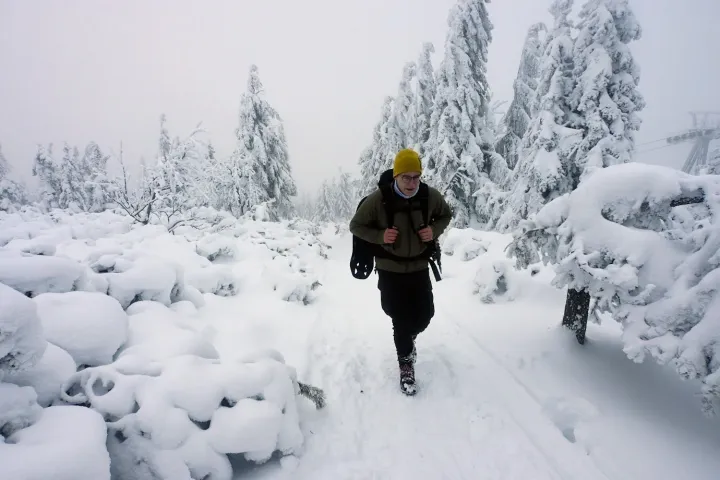
From Pec pod Sněžkou to Růžohorky shelter – Photo: Gábor Tenczer / Telex
As the hills rise, the beautiful snowy pines fade away. Instead, strange-looking statues made of ice crystals stand guard here and there along the road. They were also trees in summer, but the icy winds put a thick layer of crystals on them, so they often resembled mountain reefs built of glacial snow. We feel it too: the wind is getting stronger, and soft ice crystals are hitting us in the face.
Approaching the summit, only one landmark remained: the marked stake every fifty metres, on which the wind had built an ice flag. It is fortunate that it exists, because we cannot see anything in the thick white fog. Suddenly, the previously mentioned hole appears next to the road: the back exit of the mountain restaurant buried in snow. We haven't been in yet, we'll be back.
As one advances on the broad plateau, the few buildings that have been erected on this distinctive spot in the past hundred years emerge one by one from the white darkness. The ice-covered post office box, in operation since 1899, appears first in the Imperial and Royal Austrian, then Czech colours. Until 1921, postal and telegraph operator Johann Kirschliger lived here, who, in addition to delivering parcels, letters and money, also ran a small restaurant, where you could even stay. It wasn't easy. He had to go down the mountain and climb back up almost every day, often carrying 15 kilograms of cargo on his back.
After the wars, the post office was closed, but after the turn of the millennium, the Czechs rebuilt and modernized it. It is now open almost all year round, mostly between 10am and 4pm. You can get soft drinks and refreshments there, and you can send postcards to your friends from here. Even in this winter ice world, it's quite amazing.
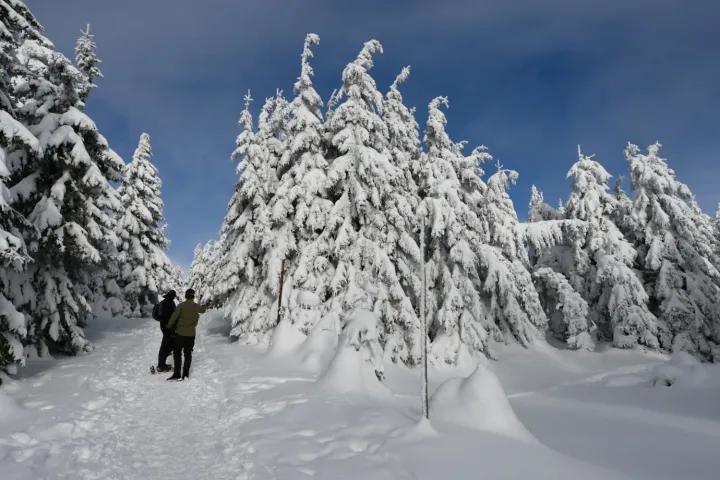
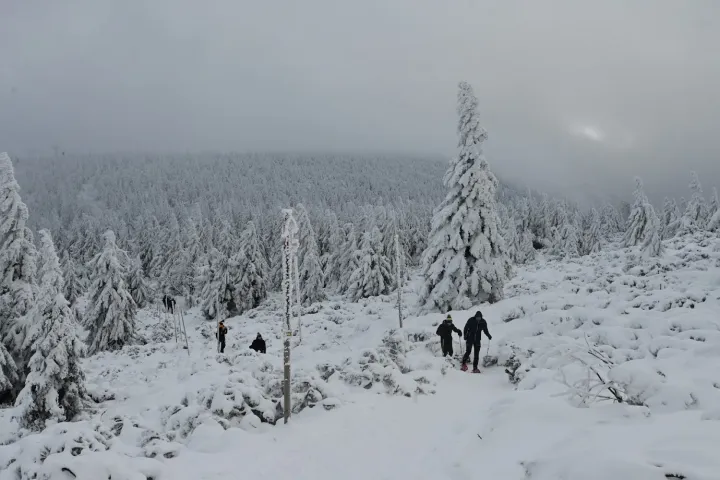
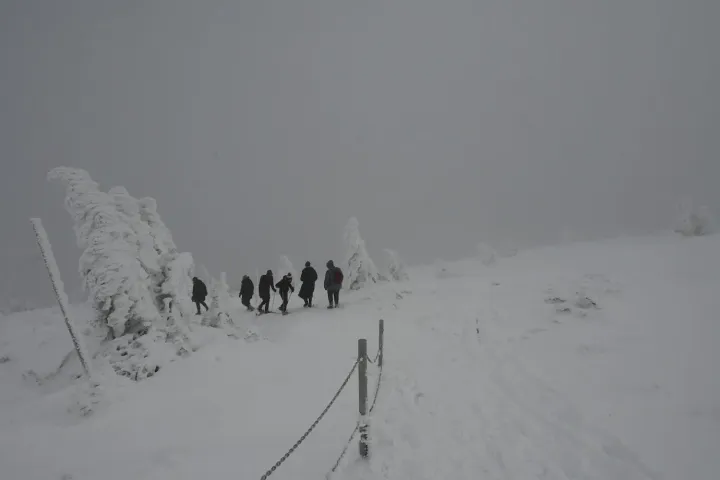

Cold Steps – Photography: Gabor Tenzer/Telex
Leaving the post office, the saucer-shaped observatory weather station built in 1974 and its adjacent St. Lorinc Church – actually on the Polish side – emerge from the whiteness. Here is also the mound or mound that marks the highest point of the roof. Avoid taking selfies of girls, we take offense to it and think that we now belong to the same third team. With King Frederick William of Prussia and US President John Quincy Adams, who also climbed the mountain in 1800 and 1804.
That's when we catch a glimpse of the dressing team, who, if we take it right by their words, come up from below, from the Polish side, in unfinished walking clothes. They seem fine, their skin is a little redder than usual. They cheerfully take pictures, then walk away, and we freeze to the ground when we see them. As it turns out, they are students of iceman Wim Hof - the one who climbed Mount Kilimanjaro wearing shorts. The ice guru has many followers in the Czech Republic and Poland, who spend years preparing for one of these Sněžka-style stunts.


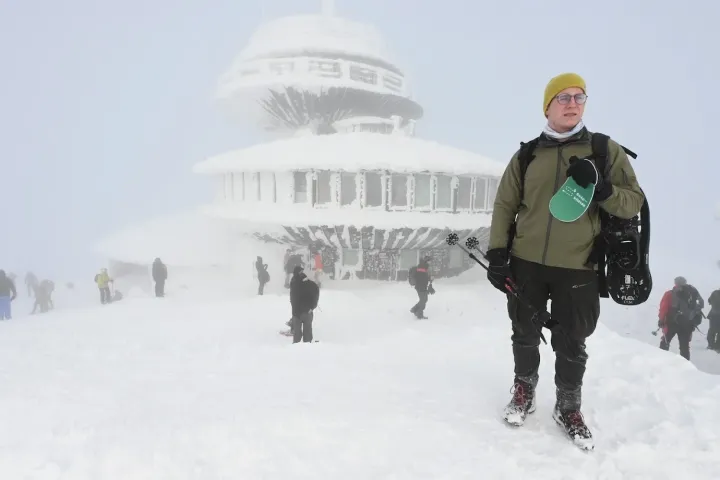

Merrilet Post Office, Weather Station, Snow Dogs – Photo: Gabor Tenzer / Telex
We think we are in good health, and with this momentum we return to the little tavern on the Czech side, which, after descending into the snow hole, turns out to also be a small cable car building. (The building sunk into the mountainside is well hidden in the deep snow.) After some hot soup, beer and the obligatory Tatra tea at the buffet, we set off down, cheering. We quickly overcame the windy, foggy and icy upper section, and the descent into the pine forest became really enjoyable.
Snezka is an excellent place for a winter mountain tour, and the 800-metre elevation difference is relatively easy to overcome. The route is well marked throughout, but I can imagine blizzard conditions when it wouldn't be worth going. In such cases, the cable car does not work anyway, please inquire about the conditions in the village. The (alleged) predictions are world champions of both Poland and the Czech Republic, but unfortunately we haven't been able to verify that now. However, the view of the high winter mountain range that prevails above is still priceless.
to update: After the article was published, one of our readers wrote that the first Hungarian Wim Hof group returned from Snezka exactly two days ago:
Andras Baxi, the group's coach, said they set out for the mountain after two months of intense preparation. In addition to its beauty and strangeness, Sněžka is also a favorite among Iceman students because Wim Hof has a house not far from the mountain, which is why they often use the mountain as a training field.
The tour route can be zoomed in on the map:
You can comment on the post and recommend other good places Also on Szépkilátás' Facebook pageAnd like the page if you haven't already! Questions and tips can come here too.
More tours in the Czech Republic:












































